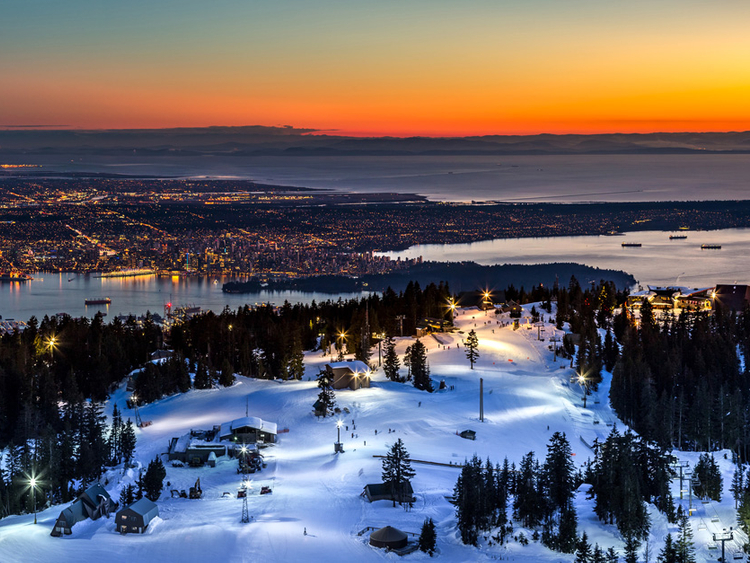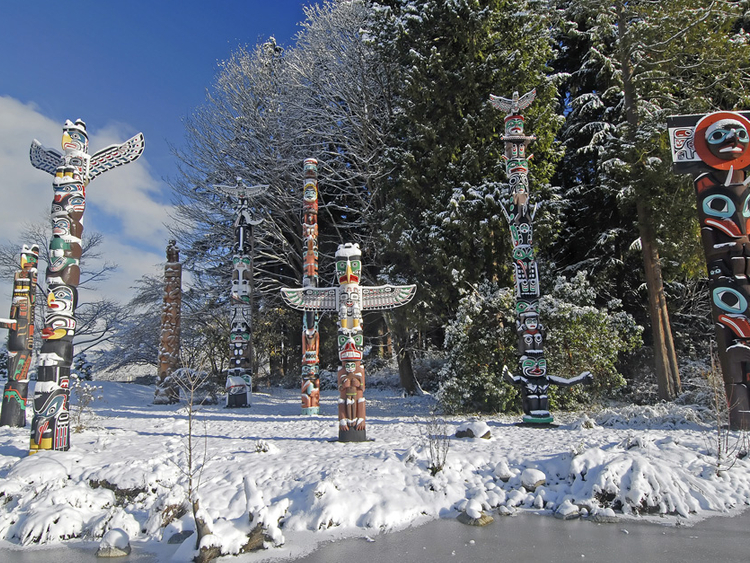As you reach the top of Grouse Mountain, either puffing and panting after the short but steep climb up Vancouver’s favourite scenic hiking trail or effortlessly disembarking the cable car, the view that presents itself neatly sums up why the city is regularly voted one of the most liveable places in the world.
In winter, the snow-capped mountain has a large ski resort, minutes from the city centre. Its lower wooded slopes are home to a teeming wildlife population, as the forest’s edge blends seamlessly with the city’s suburban backyards below, bordered on the other side by Canada’s busiest port.
Across the water, the gleaming city in the middle distance,currently growing at a dizzying speed and busting at the seams, boasts a suitably cosmopolitan skyline, a rugged contrast with the surrounding bays and islands. The Pacific Ocean stretches out to the horizon beyond.
Vancouver offers an opportunity to explore the best of British Columbia’s nature and rich Aboriginal culture on a city break that feels like an outdoor adventure. Tune out the skyscrapers, suburbs, bridges and ferries, and you’re left with a stunning natural landscape.
4,000 years of history
This pristine wilderness was home to indigenous inhabitants for more than 4,000 years before the first European settlers arrived 150-odd years ago. The descendants of these tribes, collectively referred to as First Nations, share their culture and traditions through guided tours, cultural centres and outdoor experiences that offer a sense of what life was once like in this frigid desert.
Start by walking a mile in their shoes, or rather snowshoes, on one of the trails atop Grouse Mountain. Marvel at how easy it becomes to move through the winter landscape with this ingeniously simple footwear, used by indigenous Canadians for thousands of years.
Vancouver is also home to the highest density of First Nations cultures. The city itself stands on the traditional lands of three tribes, while dozens of other groups have ties to the area. In total, almost a third of all Canadian First Nations are found in BC, resulting in a dizzying wealth of cultures, customs and languages.
Discover a piece of this rich history on a guided tour of what was once ancestral hunting grounds, now better known as Stanley Park. No visit to Vancouver is complete without a holiday selfie in front of the iconic totem poles that welcome visitors to North America’s third-largest park, where an indigenous cultural ambassador gives you a dose of history.
Like other Aboriginal peoples, Canada’s First Nations consider themselves as belonging to the natural world, rather than owning it. Before colonisation permanently impacted their lives, they lived sustainable, low-impact lives in tune with their surroundings and the seasons, their core values preserved through stories, song and rituals. That’s why tangible manifestations of indigenous settlement are few and far between.
First Nations food
But a taste of what they ate can be had at Salmon 'n' Bannock Bistro. The city’s only First Nations restaurant proudly proclaims, “We got game”, with free-range boar and bison taking pride of place on the menu, though halal-friendly options such as the salmon sampler are equally delicious.
Owner Inez Cook deftly navigates the line between providing comfort food for her First Nations clientele and introducing non-indigenous diners to unfamiliar foods. The contemporary yet authentic interpretations of traditional recipes are a feast for all senses, but some of the most sought-after, unusual produce, such as the tiny eulachon fish and foamy soapberry ice cream, are kept off the menu. Cook decides on a case by case basis who is worthy of sampling these treats, which are always in short supply.
Cultural immersion needn’t stop when you check into your hotel if you book a room at Skwàchays Lodge. The boutique art hotel with a community outreach and Aboriginal artist-in-residence programme takes its name from the traditional title of the surrounding area at the head of False Creek in Downtown Vancouver.
On a chilly winter’s evening, get your sweat on with a traditional sweat-lodge ceremony on the idyllic rooftop garden. Aside from heating you up, the ritual aims to purify heart, soul and spirit, and forge a deeper connection between participants and Mother Nature.
Whether it’s outdoor adventures, nature excursions, or cultural explorations, in First Nations Vancouver, the experience always runs deeper than appearances may suggest.
Flights from the UAE to Vancouver are via Los Angeles or Seattle, but several airlines, including Air Canada and the UAE flag carriers, fly direct to Toronto
-----
5 more First Nations experiences
More than 600 recognised Canadian First Nations are often divided into six main geographical groups. Once you’ve experienced Pacific Coast First Nations culture in Vancouver, find out more about how Indigenous people adapted to life in other parts of today’s Canada with these cultural experiences.
1. On the east coast of Canada, Nova Scotia’s Kejimkujik National Park offers camping, canoeing, wildlife and an encounter with the Mi’kmaq, one of the Woodland First Nations.
2. Alberta’s evocatively named Head-Smashed-In Buffalo Jump World Heritage Site shows how the Plains First Nations hunted bison — by driving them over a cliff.
3. The Ktunaxa Plateau tribe market a Speaking Earth package combining authentic nature and culture with a luxury resort in the Canadian Rockies.
4. The First Nations of the Yukon and Mackenzie River Basins lived in a harsh environment, but tourists now visit for the Aurora Borealis. Discover the folk legends around the lights on a tour in Yellowknife, complete with dog-sledding.
5. Six Nations of the Grand River, near Brantford, Ontario, is the most populous reserve in Canada. It is home to members of all six of the Iroquoian First Nations. Chiefswood National Historic Site offers poignant insights into early interactions between First Nations and British settlers. Sixnationstourism.ca




